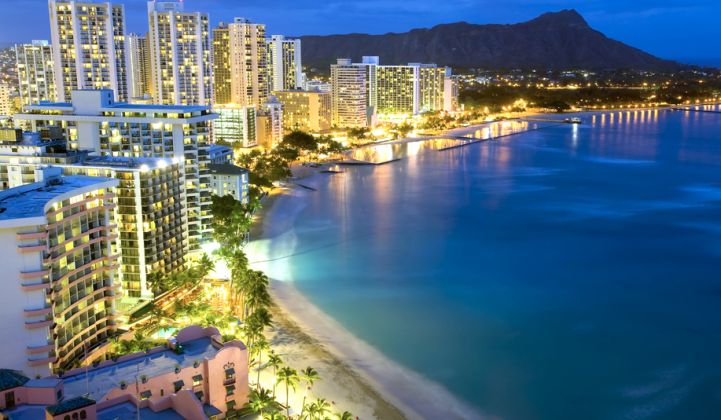Hawaiian Electric Companies, tasked with powering multiple island grids with 100 percent green energy by 2045, has finally secured regulator approval for a plan to get there -- as long as it includes customers and third parties in the mix.
On Friday, the Hawaii Public Utilities Commission approved (PDF) the utility’s Power Supply Improvement Plan, or PSIP, a sprawling document that contains the recipe for hitting the state’s 100 percent renewables mandate by 2040, five years ahead of schedule.
It’s an important milestone for the utility, which has seen two previous proposals rejected by the PUC, first in 2015 for being too vague, and then in 2016 as part of rejecting its merger with NextEra Energy Resources. The PUC recognized these setbacks in its decision, thanking Hawaiian Electric for its attention to detail and stakeholder involvement, and imploring it to “move quickly” to implement the near-term parts of the plan.
Hawaiian Electric Companies' three utilities -- Hawaiian Electric on Oahu, Maui Electric on Maui, Molokai and Lanai, and Hawaii Electric Light on the Big Island of Hawaii -- already boast some of the highest shares of renewable energy in the country, all on islands isolated from the stability of neighboring grids. That’s made them a natural testing ground for new technologies and regulatory models, including battery-backed solar and wind farms, aggregated demand response and energy storage, peak-shifting electric vehicle charging, and voltage-smoothing smart inverters and grid power electronics.
The PSIP incorporates all of these efforts into the utilities’ long-range energy procurement, generation, and transmission and distribution grid investment plans. Friday’s decision frees the Hawaiian Electric Companies to move ahead immediately with certain near-term steps on that vision, including grid-scale renewable energy procurement, community-based renewable energy, demand response and distributed energy resources, and grid improvements on each island.

Source: Hawaiian Electric Companies' 2016 Power Supply Improvement Plan
The grid-scale renewables plan calls for nearly 400 megawatts of new renewable energy procurements through 2021, collectively the largest procurement in the state’s history, it noted. It's also expecting nearly as much rooftop solar capacity to be added over the same period. The utility should move quickly to take advantage of the federal Investment Tax Credit that is set to expire within that timeframe, and to make sure to involve stakeholders in crafting PPAs that incorporate energy and grid services, the PUC wrote.
The decision also exressed support for the community-based renewable energy program, which offers customers a subscription in community solar projects that earn 20 percent higher rates between 5 p.m. and 10 p.m. to help reduce ramps in energy demand -- a profile that could well involve energy storage, as well as load control. Customer-facing DER programs like “smart export tariffs” also won backing, along with activating advanced solar inverters capabilities, and work on demand response programs.
Friday’s order does take issue with some parts of the plan, however, including the lack of evidence that Hawaiian Electric Co. has sought to identify customer-based alternatives to utility-owned battery systems, such as pumped hydropower, thermal and electrical storage options, or demand-side energy storage. Likewise, its near-term transmission plan lacked a thorough analysis of whether distributed generation, demand response, or behind-the-meter batteries could avoid the need for traditional grid investments.
On the generation side, the PUC questioned the plan’s reliance on procuring up to 100 megawatts of “firm, dispatchable, flexible generation” on Oahu, and warned that any such plans will have to include the option of a competitive bidding process that involves storage, demand response or energy efficiency.
Finally, while the PUC commended the utility on its 100-percent-by-2040 goal, it’s concerned about the plan to increase rates by increments ranging from 18 to 25 percent over the course of its near-term action plan. “The companies do not appear to have evaluated the capital investments, financial commitments, and the resulting increasing rates, in the context of affordability to customers and the risk of stranded assets,” the commissioners wrote. Not only would this increase be hard on customers who struggle to pay their utility bills, but it could also increase the rate of "uneconomic customer exit," or going off-grid completely -- and "the risks associated with such decisions rests with the Companies."
The PUC said it will create a new docket to continue tracking the utility's progress toward reaching its clean energy goals.



